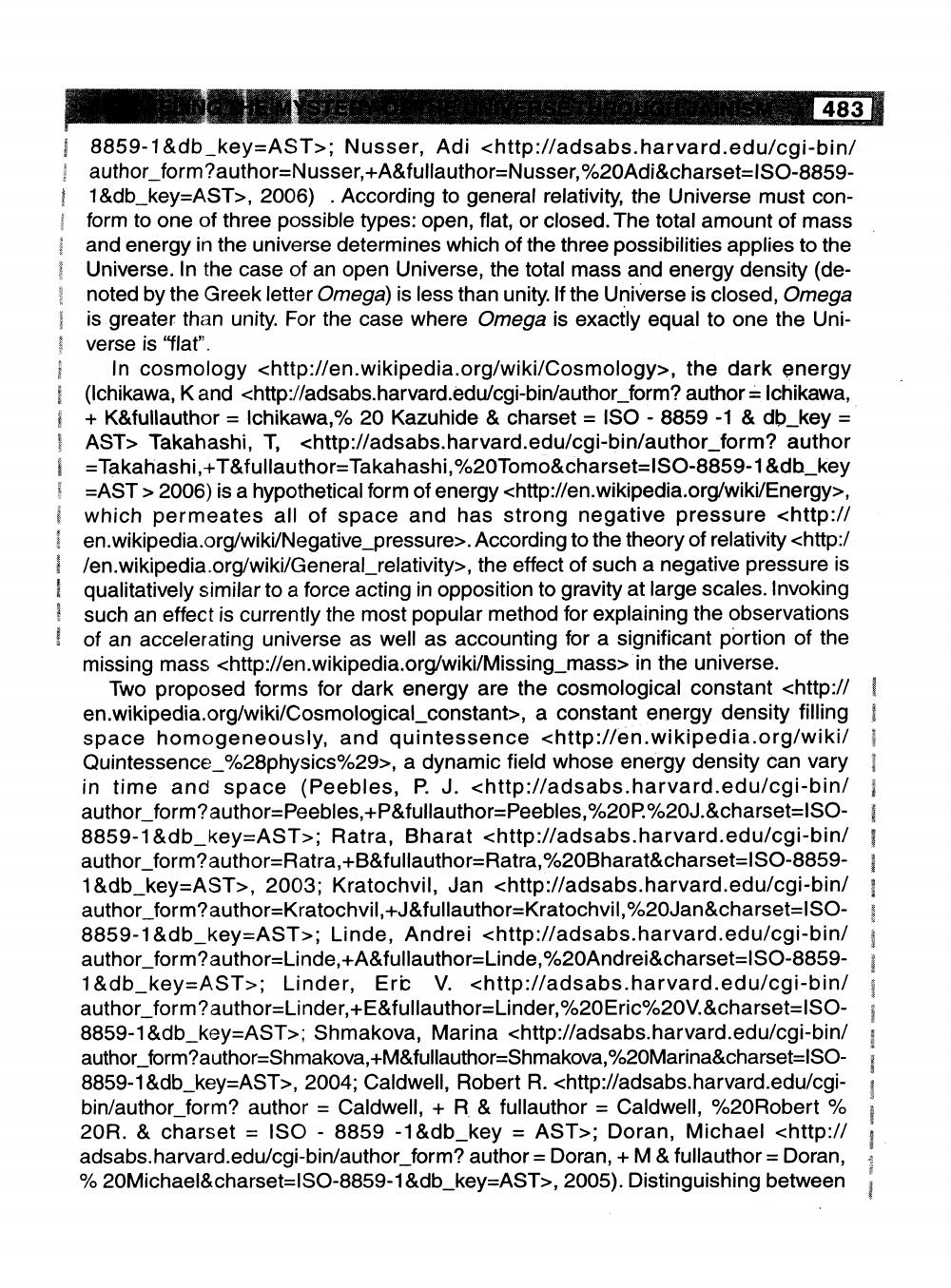________________
MENGHE MYSTEER
O NVERGESSLEINER 483 1 8859-1&db_key=AST>; Nusser, Adi <http://adsabs.harvard.edu/cgi-bin/
author_form?author=Nusser,+A&fullauthor=Nusser,%20Adi&charset=ISO-88591 1 &db_key=AST>, 2006). According to general relativity, the Universe must con1 form to one of three possible types: open, flat, or closed. The total amount of mass
and energy in the universe determines which of the three possibilities applies to the 1 Universe. In the case of an open Universe, the total mass and energy density (de
noted by the Greek letter Omega) is less than unity. If the Universe is closed, Omega 1 is greater than unity. For the case where Omega is exactly equal to one the Universe is "flat".
In cosmology <http://en.wikipedia.org/wiki/Cosmology>, the dark energy (Ichikawa, Kand <http://adsabs.harvard.edu/cgi-bin/author_form? author = Ichikawa,
+ K&fullauthor = Ichikawa,% 20 Kazuhide & charset = ISO-8859-1 & db_key = 1 AST> Takahashi, T, <http://adsabs.harvard.edu/cgi-bin/author_form? author
= Takahashi,+T&fullauthor=Takahashi,%20Tomo&charset=ISO-8859-1&db_key =AST > 2006) is a hypothetical form of energy <http://en.wikipedia.org/wiki/Energy>, which permeates all of space and has strong negative pressure <http:// en.wikipedia.org/wiki/Negative_pressure>. According to the theory of relativity <http:/ len.wikipedia.org/wiki/General_relativity>, the effect of such a negative pressure is qualitatively similar to a force acting in opposition to gravity at large scales. Invoking such an effect is currently the most popular method for explaining the observations of an accelerating universe as well as accounting for a significant portion of the missing mass <http://en.wikipedia.org/wiki/Missing_mass> in the universe.
Two proposed forms for dark energy are the cosmological constant <http:// en.wikipedia.org/wiki/Cosmological_constant>, a constant energy density filling i space homogeneously, and quintessence <http://en.wikipedia.org/wiki/ Quintessence_%28physics%29>, a dynamic field whose energy density can vary 1 in time and space (Peebles, P. J. <http://adsabs.harvard.edu/cgi-bin/ author_form?author=Peebles,+P&fullauthor=Peebles,%20P.%20J.&charset=ISO- 1 8859-1&db_key=AST>; Ratra, Bharat <http://adsabs.harvard.edu/cgi-bin/ 1 author_form?author=Ratra,+B&fullauthor=Ratra,%20Bharat&charset=ISO-8859- 1 1&db_key=AST>, 2003; Kratochvil, Jan <http://adsabs.harvard.edu/cgi-bin/ author_form?author=Kratochvil,+J&fullauthor=Kratochvil,%20Jan&charset=ISO8859-1&db_key=AST>; Linde, Andrei <http://adsabs.harvard.edu/cgi-bin/ author_form?author=Linde,+A&fullauthor=Linde,%20Andrei&charset=ISO-88591&db_key=AST>; Linder, Eric V. <http://adsabs.harvard.edu/cgi-bin/ author_form?author=Linder,+E&fullauthor=Linder,%20Eric%20V.&charset=ISO8859-1&db_key=AST>; Shmakova, Marina <http://adsabs.harvard.edu/cgi-bin/ author_form?author=Shmakova,+M&fullauthor=Shmakova,%20Marina&charset=ISO8859-1&db_key=AST>, 2004; Caldwell, Robert R. <http://adsabs.harvard.edu/cgibin/author_form? author = Caldwell, + R & fullauthor = Caldwell, %20Robert % 20R. & charset = ISO - 8859 -1&db_key = AST>; Doran, Michael <http:// adsabs.harvard.edu/cgi-bin/author_form? author = Doran, + M & fullauthor = Doran, %20Michael&charset=ISO-8859-1&db_key=AST>, 2005). Distinguishing between




